City Streets Makeover Adds Bike Lanes
60 miles of streets resurfaced, many with new bike lanes.
Leveraging its High-Impact Paving Program, the City of Milwaukee is rapidly adding new buffered bike lanes and replacing existing worn bike lanes and cross walks on major streets across the city. The program was started in 2013 to try to stretch existing maintenance funding after years of state cuts in shared revenue to municipalities, and seeks to make quick, relatively low-cost repairs to roadways in dire need of resurfacing.
This generally involves milling a couple inches off the existing damaged asphalt surface and adding a new layer of asphalt and pavement markings. The projects do not repair curbs, gutters and sidewalks as would be done in a typical full reconstruct project. The repairs are designed to last seven to 10 years, and the city has been able to resurface more than 60 miles of streets with the HIPP. Of those 60 miles, approximately 25 percent were local (residential or side) streets. In 2017 DPW plans to complete approximately 24 miles of streets with the HIPP, of which eight miles will be local. Thanks to the High-Impact Paving Program and the city’s gradual increases in DPW’s capital budget, Milwaukee has reduced the average replacement cycle for roads from 163 years (you read that correctly!) in 2004 down to 58 years. Given that a street should last 25-60 years, depending on if it is constructed with asphalt or concrete, that is about where the replacement cycle should be.
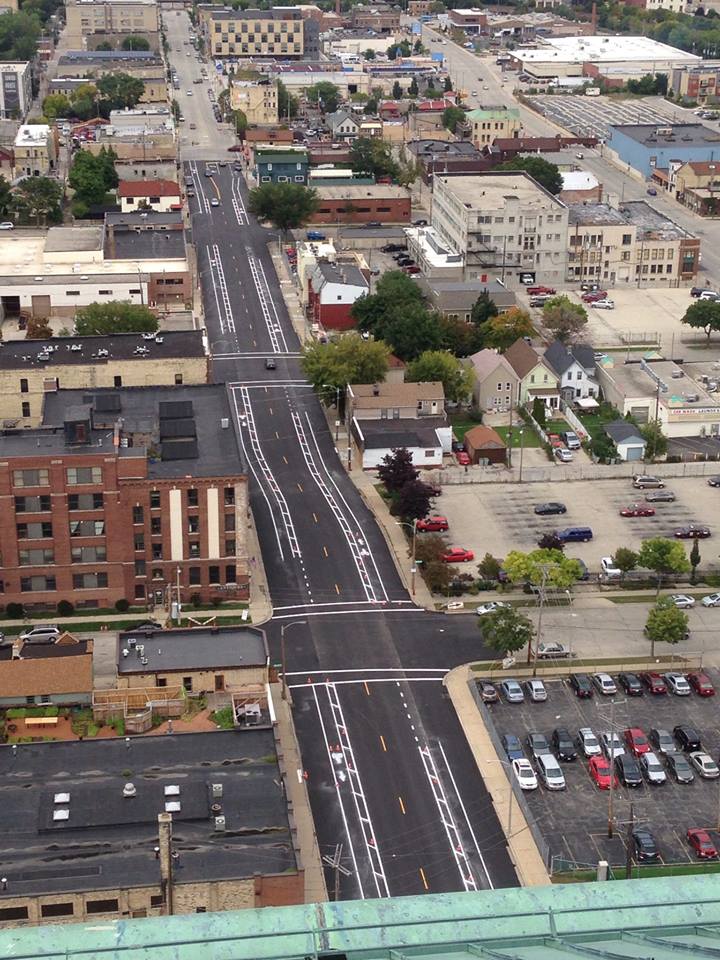
A view from the Rockwell Clock Tower of the buffered lanes on 2nd installed with the High Impact Paving Program.
When an arterial street is resurfaced as part of the rapid fix program, the city evaluates current traffic volumes and is able to make some geometric updates if needed using the new pavement marking patterns. In many cases these roadways were widened decades ago to serve our then growing traffic volumes during Milwaukee’s industrial heyday when thousands of factory workers began driving to work in large factories. Those big peak-hour traffic volumes required the city to widen many of our historic boulevards and streets.

Unfortunately, this happens. People use the new buffered bike lanes on Roosevelt to speed and pass people on the right. The solution is protected lanes.
Since most of those factories are no longer open, the streets have more travel lanes than needed, which encourages speeding. If those streets were repaired with a more expensive full-reconstruction project, the entire roadway might be narrowed by moving the curbs in. That is what was done on S. 2nd Street by Rockwell and north of National Ave. When the street was reconstructed the sidewalk areas were widened and bike lanes were added where the now-unneeded extra vehicle lane was added years ago. This process is commonly called a “road diet” and is happening in cities across the country.
Roosevelt Boulevard is a good example of a street that went on a road diet as part of the more limited High-Impact Paving Program. Last year Roosevelt went from four motor vehicle travel lanes and two parking lanes to two motor vehicle travel lanes, buffered bike lanes and parking lanes. The new pavement marking geometrics still provide adequate capacity to manage peak-hour traffic volumes, and they lessen the feeling that people are driving on a freeway and can go 50 mph.
Minneapolis is on track to have 44 miles of protected bike lanes and Chicago now has more than 100 miles of protected bike lanes, with many new projects being curb-protected bike lanes. Milwaukee currently only has one protected lane — on Bay Street. The quick-fix HIPP understandably doesn’t have funds for those higher level bicycle improvements, but now that the city has caught up with street repairs, it would make sense to begin budgeting to add protected bike lanes like our peer cities.
The other bike projects done this year are listed below. The list was handed out at the Bicycle and Pedestrian Task Force, held on Friday, October 21st. Kristin Bennett, the City of Milwaukee Bicycle and Pedestrian Program Manger, updated those in attendance with a detailed list of project improvements done to date this year The project updates list below also shows the new bike lane locations added with the city’s annual high-impact paving program:
- N. 6th/7th/Halyard (Walnut to North) – removed one travel lane in each direction for new standard and buffered bicycle lanes.
- S. 16th Street (Windlake to Oklahoma) – removed one travel lane in each direction and added new buffered bike lanes and intersection turn lane improvements. No change to on-street parking.
- N. 51st Blvd (Lincoln Creek Bridge to Hampton) – removed one travel lane in each direction and added new bicycle lanes. No change to on-street parking.
- N. Atkinson St. (Keefe to Capitol) – removed one travel lane in each direction and added new bicycle lanes plus a continuous center turn lane. No change to on-street parking.
- W. Center Street (N. 20th to 27th) – replaced existing bicycle lanes with minor modifications
- W. Grange Avenue (S. Howell to S. 6th) – removed one travel lane in each direction, replacing them with buffered bike lanes.
- N. Jefferson Street (St. Paul to Erie) – added new bicycle lanes, no changes to parking or travel lanes
- W. Lincoln Avenue (S. 16th to Layton/27th) – replaced existing bicycle lanes with minor modifications
- W. Morgan Avenue (Forest Home to S. 68th) – replaced existing bicycle lanes with minor modifications
- N. Oakland Avenue (Edgewood to Park Place) – replaced existing bicycle lanes with the addition of green bike lane markings on southbound Oakland at Locust Street (right turn lane)
- W. Oklahoma Avenue (S. Chase to S. 6th) – added new bicycle lanes, on-street parking removed
- W. Roosevelt Drive (Fond Du Lac to N. 36th) – removed one travel lane in each direction, replaced with buffered bicycle lanes and wider parallel parking lanes
You can read the complete project update from the city by clicking on the thumbnail image to the right. While the majority of projects have been progressing, the city has fallen behind schedule on some long anticipated projects. Perhaps most notable is the Transportation Alternatives Program grant to hire a consultant to create a pedestrian plan for the City of Milwaukee. That grant has a four-year life cycle, but has progressed so slowly that the city has had to request access to the grant funds again.
Still, the city is making good progress on the pedestrian program despite the lack of a formal plan. As the list to the right details, there have been many new crosswalk call buttons added. Not listed, but significant, the city recently constructed a raised intersection near the Bike Fed’s Milwaukee office at S. 37 and W. Pierce streets. The raised intersection was installed to improve safety at the busy crosswalks by the ramp to the Menomonee Valley Passage to the Hank Aaron State Trail. The number of people walking and bicycling in the area has skyrocketed there since the opening of the Urban Ecology Center, La Esquela Verde, and the Bike Fed office. There is a lot of speeding on Pierce St. (AKA “The Polish Highway”), so the neighbors have been asking for traffic calming. This is the first step at the busiest intersection.
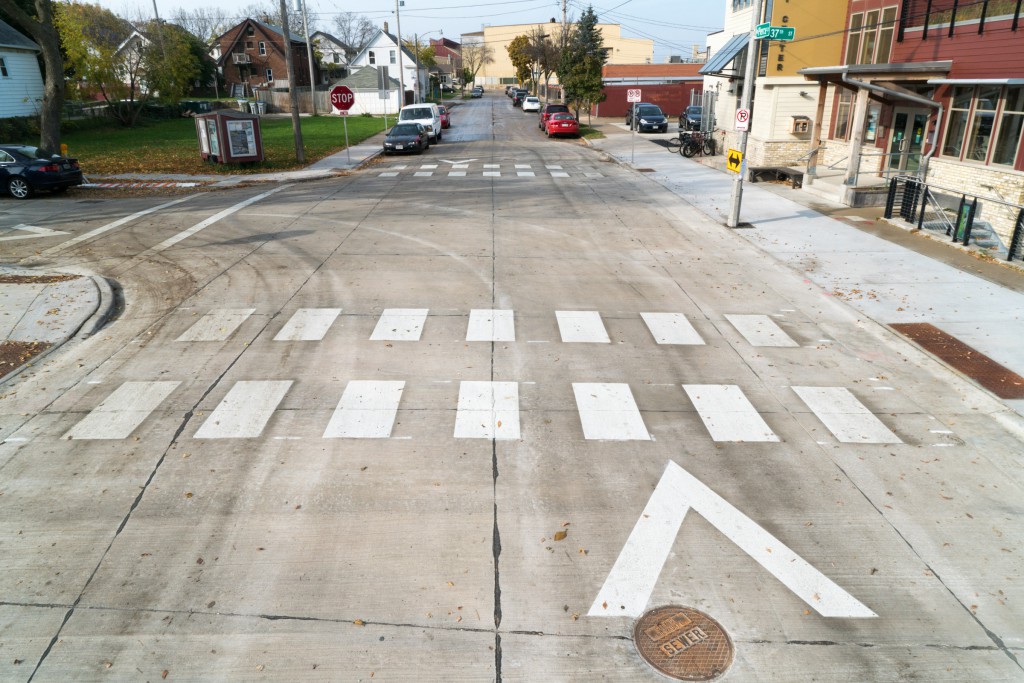
It is hard to see, but if you look to the right, you can tell there is no vertical curb face past the curb ramp detectable warning fields at the edge of the crosswalk.
If you read thought the PDF of the report linked above, you will see “no significant activity on this project due to staff medical leave” under a few other grant projects. The slow progress on existing grants was mostly because Bennett was hit by a car on Water St. while riding home from work. The crash was serious and her injuries forced her to miss quite a bit of work. The good news is she is doing much better and back at work.
After his Bike to Work with the Mayor ride last June Bike Week, Mayor Tom Barrett announced the city was forming a group to recommend projects and policies to get Milwaukee a Platinum Bicycle Friendly Community rating from the League of American Bicyclists. We applaud that commitment, but look forward to the first new protected bike lanes, neighborhood greenways network (sometimes called bicycle boulevards, or safe streets) or other next generation bicycle improvements to encourage more people to ride in Milwaukee.
While adding more buffered and traditional bike lanes is definitely a step in the right direction, no city can go Platinum without protected bike lanes and a network of safe streets, and other next generation changes from the NACTO guide. If we really do want to make Milwaukee a better city for cycling, we only have to look at the NACTO guide and what other big cities in the US have been doing for the last five to 10 years.
As a still-proud son of Milwaukee, I appreciate that our city faces very significant problems, most of which have no easy solutions. But we believe that is all the more reason to double down on cycling. Bicycling is a simple, inexpensive and proven solution to many complicated problems our Milwaukee faces today.
What can you do to help move Milwaukee closer to Platinum? Take a moment to call or email your alderperson and the Mayor and tell them why you think bicycling is a simple, cost-effective way to make Milwaukee an even better place to live, work, and do business for all of our residents. Our elected officials tell us they hear about trash pick-up, taxes, snow plowing and crime all the time. If we want to move cycling further up their priority list, we have to speak up. When is the last time you contacted any of your elected representatives? If it has been more than a year, it is time to reach out.
You can also provide your input to improve bicycling and safer streets throughout Milwaukee by taking this survey from the Path to Platinum Committee, which is working to advise the city on how to get the Platinum rating.
Bike Czar
-
Join a Bike Ride Under the Polish Moon
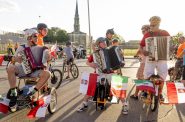 Jun 1st, 2018 by Dave Schlabowske
Jun 1st, 2018 by Dave Schlabowske
-
9 Reasons to Join National Bike Challenge
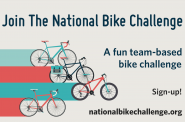 May 4th, 2018 by Dave Schlabowske
May 4th, 2018 by Dave Schlabowske
-
Biking Through the Mindoro Cut
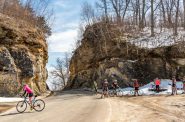 Apr 27th, 2018 by Dave Schlabowske
Apr 27th, 2018 by Dave Schlabowske


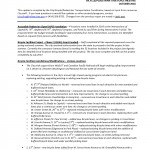
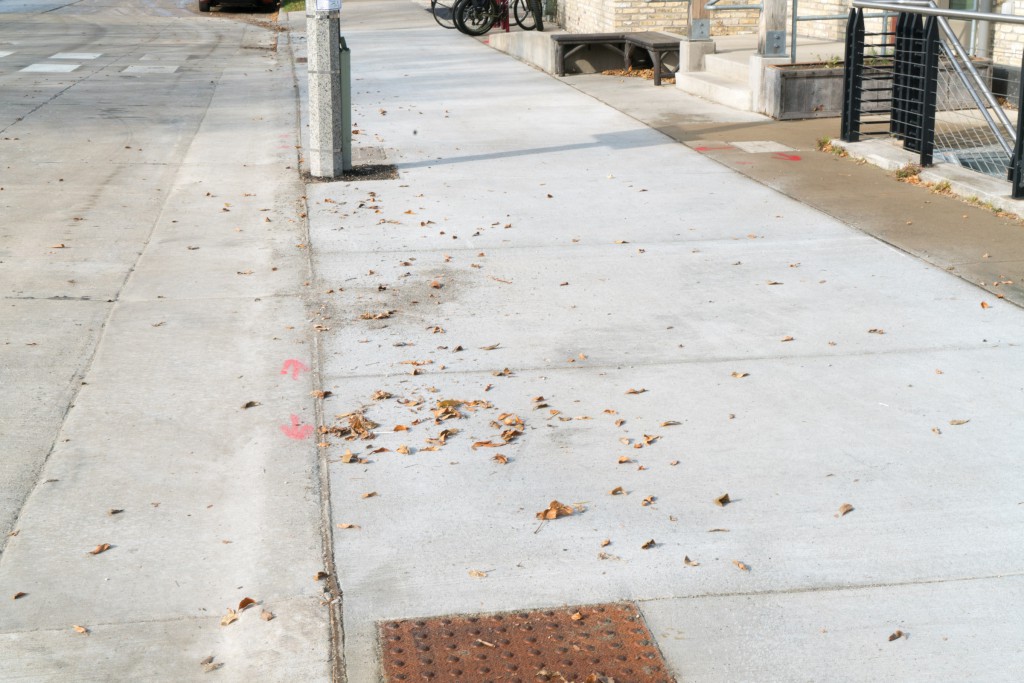




















I drive on Roosevelt almost every day and I agree it is a real problem and actually more dangerous for everyone with lots of people passing on the right. One issue is this was a solution looking for a problem. In the four years or so since they put in the bike lane, I have yet to witness a single biker using the bike lanes on that stretch. Maybe it is because it is so dangerous? The other problem is they took away driving lanes without adding turn lanes. So in rush hour, traffic can be backed up two blocks if someone is making a left turn. I can’t blame folks for using these unused lanes to go around turning vehicles, but on Roosevelt it is basically certain people’s personal fast lane.
I understand HIPP was designed for and thus doesn’t have funds for even small improvements, like bollards, but what kind of costs are we talking here? If another $0.50 on the city wheel tax makes it happen, sign me up!
Wheel taxes are a hot topic right now, but if one can see the direct results of it — such as HIPP — it isn’t so bad.
Personally, I’m with you Rich, I’d pay a higher City or County wheel tax. Those flexible traffic posts are probably about $25 each, plus installation. I’d be willing to pay more for on-street bicycle facilities if I know the money is going for something like adding those. That said, Minneapolis has protected bike lanes in high demand corridors and I don’t think they have a local wheel tax. That is sad, because they didn’t have any protected lanes in the Twin Cities and neither did Chicago when Milwaukee installed the pilot raised bike lane on Bay Street. Now we still have that one pilot project and our neighbors all have pretty built out networks. I think it is more a matter of political will than fiscal priorities. I have been thinking that the Wisconsin Bike Fed needs to work harder at the local level to grow grass roots and political support for things like protected lanes. To reference the Twin Cities again, the Bicycle Alliance of Minnesota has partnered with Blue Cross and other organizations to create the Bikeways for Everyone campaign.
The next step is for Milwaukee to commit to Vision Zero — an infrastructure plan to eliminate traffic fatalities in the city. Cities around the world are working toward this, and Milwaukee should join them.
“People use the new buffered bike lanes on Roosevelt to speed and pass people on the right. The solution is protected lanes” — maybe another solution is not putting high speed traffic and bikes on the same street. As a daily bike commuter I would much rather be on a quiet side street without any bike infrastructure than on a main arterial street with bike infrastructure — especially when biking with my family. Why stops us from putting money to making sides streets more bike friendly (less friendly to through car traffic) by simply turning stop signs adding speed bumps with cut outs for bikes… Bike advocates could even win favor from local residents who also want to see speeds reduced on their side streets (see evidence of home value rising along bike boulevards http://www.streetfilms.org/portland-or-bicycle-boulevards/). Let cars have their fast multiple lane roads. Even with painted lanes cars will swerve into bike lanes when a car even hints that it is turning left. Oakland Avenue is a prime example. A large number of UWM students are utilizing the Bublr bikes to head up and down busy Oakland when nearby Kramer or Murray would give them a much safer, quieter, more scenic ride through the neighborhood. Going down Oakland forces bikers through difficult intersections at Locust and North Avenues where right turning traffic conflicts with the bike lanes. We should stop adding bike lanes to busy streets and instead invest that money into making side streets bike boulevards.
http://www.streetfilms.org/portlands-bike-boulevards-become-neighborhood-greenways/
I’m in favor of a $50 annual bicycle tax to pay for these projects.
Since road wear is proportional to weight, a $50 fee is about $2.50/lb for a bike. I’d be OK paying that fee as long as a regular 4,000 lb car pays their yearly $10,000 fee.
I guess those lines and bike only bridges get done for free.
@MKE_BikeCommuter, The Wisconsin Bike Fed has long been an advocate for a network of traffic calmed side streets. They can’t substitute for safe, convenient access on arterials though, we need both to people can get where they need to go. Most bicycle destinations are on arterials, which is why most other cities with more developed bicycle networks have both protected lanes and the side street network. To your point, when we worked on the 2010 update to the City of Milwaukee Bicycle Plan with Alta Planning + Design, we included a proposed network of “bicycle boulevards.” See page 69 for a discussion about bicycle boulevards and Map 7, p. 116. As you pointed out, Bike Boulevards also have the benefit of making the streets safer and more pleasant for the residents who live there, and they can easily incorporate passive stormwater management, something MMMSD is very interested in to help reduce overflows.
Because Bicycle Boulevards have broader benefits than just for cycling, they are now often referred to as neighborhood greenways or a safe streets network. We like this more inclusive descriptor and continue to advocate for them. I believe just such a redesign is in the works for Fratney.
Well, we know roads aren’t free & drivers don’t pay for the full cost… why the focus on bicycles?
This funding question is a much bigger issue, but everyone agrees our transportation funding system is broken no matter which mode you look at. At this point, our elected leadership doesn’t seem to have the political stomach for fixing it. The simple solution, which worked for decades after the Highway Trust Fund started in 1956, has been to increase the gas tax. While it is true that people walking don’t pay for sidewalks (or even state trail passes ironically), transit users don’t pay the full cost of our bus system and people driving don’t pay the full cost of roads or any of the significant external costs. One can argue people walking and riding bicycles already pay more than their share if you factor in the external economic benefits that come from active, non-motorized transportation, but the argument has not carried the day yet.
If a reasonable wheel tax fee was proposed for bicycles and all the money went to improve cycling, I’d be willing to pay it if only to add more political leverage for bicycling. When Walker proposed diverting sales taxes from motor vehicle related sales directly to the state transportation budget, the Bike Fed suggested we do the same with bicycling. Of course we know that idea would have cut the general fund significantly, and didn’t go anywhere. We need to continue to have an honest discussion about how to fund our transportation system for all modes: motor vehicles, bicycling, walking and transit. As unpopular as it is to say, probably everyone will have to pay more.
Tim, sorry if you think I’m focusing on bicycles. I don’t mean to be. btw, are you aware that Scott Walker has stopped all funding for State Parks, including the trails which you must pay for if you want to walk on them? “Moving to more of a user-based system is very appropriate,” said Sen. Tom Tiffany (R-Hazelhurst), a member of the Joint Finance Committee that recommended the changes. The people who use the service should pay for the service.” Now Tiffany is an idiot but what with me paying for two wheel taxes soon along with license, registration, sales taxes on my initial purchase, oil and tire dispersal fees etc. I don’t think it’s unreasonable to ask for the bicyclist to pay for the neat things they’ve gotten in the last 10, 15 years. I would also argue that cars do pay for our highways in full, as if they were limited to cars only they might last a lifetime. The trucking industry may pay higher taxes, but they are woefully undertaxed when you figure in the wear they cause. I am a former bicyclist myself one year having pedaled every working day save 4. When I was a kid, I needed a license and had to go to the fire department to prove I had reflectors and a working light and horn. I think I paid a buck way back then and we had no bike trails, paths, bridges or lanes so I don’t think $50 is unreasonable.
@Observer, I hope we all welcome a civil discussion about how we fix our broken transportation funding system. Users paying for what they use and the external costs they place on society is certainly a valid proposal. State parks and trails are off the general fund, but only people who ski or ride bikes have to pay for the trails and you only pay to use a park if you drive into it, neighbors who live next to parks and walk in don’t pay at all. Ride a bike in and hike and you also don’t pay. As for defining the costs, I think it has been a problem getting people to agree on the “facts.” For instance you argue the trucking industry is subsidized by everyone else, but the industry disputes that and has actually won lawsuits to get fees reduced. Another example is many people argue people who drive don’t pay for the pollution and crashes caused by their motor vehicles. And many of our leaders don’t believe vehicle emissions play a roll in climate change or impact health. Then we have the argument made by many bicycle advocates who cite studies showing cycling has a net positive economic impact (see http://grist.org/biking/one-mile-on-a-bike-is-a-42-economic-gain-to-society-one-mile-driving-is-a-20-loss/). It might be difficult, it might be difficult for us to come to an agreement on a user-based balance sheet. That said, the more we talk about these things honestly and politely, the closer we can come to fixing the funding problem.